Introducing Baguio City

Baguio City Guide
Overview
Baguio is a first-class, highly urbanized city located in the Philippines’ Cordillera Administrative Region. Due to its elevation of 4,810 feet over mean sea level, it also makes it ideal for the growth of mossy plants, orchids, and pine trees. It attributes its other moniker to the “City of Pines.” Due to its cool climate, it is known as the “Summer Capital of the Philippines.”
Business, trade, and education are all centered in this city, which also serves as the administrative capital of the Cordillera Administrative Region. Baguio had a population of 366,358, according to the last census in 2020.
Short History
The Ibalois and Kankanaeys were the first people to settle in Baguio’s areas. Baguio City’s old name, Kafagway, was hardly affected by the Spanish zeus or military station in La Trinidad, Benguet.
Baguio gained attention after the Americans took control of the Philippines. It was a popular summer holiday destination for many American soldiers, from the highest ranks to the lowest enlisted ranks, to escape the summer heat. Since then, it has been dubbed the Summer Capital of the Philippines.
On September 1, 1909, the city of Baguio was made a charter city, making it the second in the Philippines after Manila. During this time, the city of Baguio was significantly expanded, with new parks and public buildings dedicated to notable figures such as former governor-general Luke E. Wright, city planner Daniel Burnham, and others.
Landmarks
Tourist Spots
- Burnham Park
- Camp John Hay
- Mines View Park
- Strawberry Farms in La Trinidad
- Tam-Awan Village
- Baguio Night Market
- Wright Park
- The Mansion
- Baguio Cathedral
- Easter Weaving Room
Museums
- BenCab Museum
- Museo Kordilyera
- Baguio Museum
- Bell House Library Museum
- Tam-Awan Village
- Galleria De Potenciana by Arca’s Yard
- Ililikha Artist Village
- Victor Oteyza Community Art Space Gallery
While you’re there
Things to see & do
Visit Camp John Hay
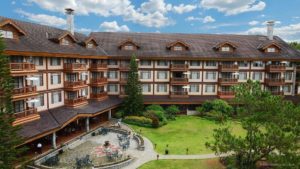
Camp John Hay in Baguio city.
If you only have a limited time to visit Baguio attractions, Camp John Hay is a great place to start. Previously, the camp served as a rest and amusement center for returning American soldiers.
It has evolved into one of the top places to visit in Baguio throughout the years. It has several must-see tourist attractions in one handy location. It may be the best tourist attraction in Baguio City.
This sizeable recreational complex provides visitors with a wide range of enjoyable activities. It features the finest of Baguio: pine trees, pure air, a pleasant breeze, and a tranquil ambiance. If you’re seeking activities to do in Baguio with your family, this is a fantastic alternative.
Eco-adventures and nature communes are both options. One of the most exhilarating activities at Camp John Hay is Treetop Adventure, which features a variety of thrilling attractions such as the Superman Zipline, Tree Drop, and Canopy Ride.
Enjoy the Strawberry Farms in La Trinidad
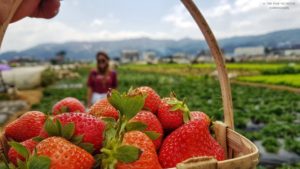
Strawberry Farms in La Trinidad.
There are many things to see and do in nearby La Trinidad, including the strawberry farm, a must-see when visiting the Summer Capital.
La Trinidad, the capital of Benguet, is about 30 minutes from the Baguio town proper. This municipality is where you’ll find hectares of land dedicated to growing strawberries to supply the rest of the country. It is one of the most frequented Benguet tourist spots.
It’s possible to grow a wide variety of vegetables and fruits in the North, but nothing beats the juicy red strawberries.
Strawberries are at their best after they’ve just been picked from the vine. So go ahead and grab a basket and go berry picking! You’ll have a deeper understanding of the Ibaloi farmers who cultivate these fields if you participate in collecting fruit.
Purchase freshly picked strawberries near the farm entrances if you prefer not to do the job yourself.
Additionally, you may purchase fresh flowers and select from a wide variety of fresh vegetables at the market. Treats like strawberry ice cream and strawberry taho are also a must-try. Lastly, don’t forget to take pictures!
Go Hiking
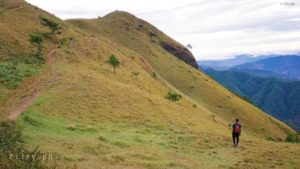
Hiking trails in Baguio.
The Mount Ulap Eco-Trail is about 40 minutes away from Burnham Park in Baguio City, a well-known landmark and tourist destination in the mountain city that serves as the Philippines’ Summer Capital.
Technically, Mount Ulap Summit is one of the most uncomplicated hikes. There are no ropes, specific mountaineering equipment, or even previous mountain climbing expertise required.
Mt. Ulap has three well-known peaks and is a manageable mountain throughout the year. Ambanao Paoay, with an elevation of 1788 meters above sea level, is the first peak. Gungal Rock, at 1814 meters above sea level, is the second-highest peak, while the summit, at 1846 meters, is the highest. Ascending to its heights will reward you with stunning views of Benguet’s sea of clouds, pine tree ridges, grassland slopes, and mountain range.
Shopping & Nightlife
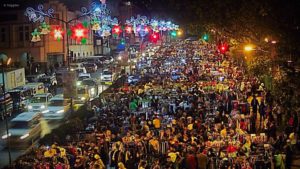
Nightlife in Baguio.
If you’re not sure what to do in Baguio after dark, swing by the city’s Night Market. Baguio is a popular destination for bargain-hunters. The Baguio Night Market is the best spot to put your haggling abilities to the test. Every thrifty fashionista’s desire is fulfilled here.
Burnham Park’s Harrison Road, northeast of Burnham Park, has an after-hours flea market every Tuesday night from 9:00 pm to 2:00 am. Because of the rows of ukay-ukay stalls, you may find everything you need to create a casual outfit without breaking the bank.
Suppose you are not familiar with what ukay-ukay is. In that case, ukay-ukay is the local phrase for surplus things shipped from other countries and second-hand clothing, luggage, and footwear offered at discounted costs.
This night market in Baguio has an abundance of ukay-ukay. It’s the ideal location to get great deals on quality pre-owned outerwear, footwear, clothing, and other accessories. If you’re skilled at thrift shopping, it’s possible to come across one-off vintage goods, even in near-mint condition.
After shopping, stop by the hill’s northern slope to have some sweet corn, noodle soup, or other street food.
Food & Drinks
There are numerous tourist attractions in the city, but it also has many restaurants that provide Filipino cuisine with international influences. Enjoy an excellent nightcap while gazing at the stars and sipping on a hot cup of coffee at a mountaintop alfresco area. We’ve produced a list of the best restaurants in Baguio to help you get a taste of the region’s cuisine while you’re here.
Foggy Mountain Cookhouse
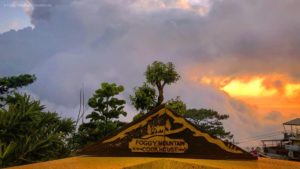
Foggy Mountain Cookhouse in Baguio.
The Foggy Mountain Cookhouse, located on a ridge near San Carlos Heights, has a large outdoor dining space. Since Chef Babes Reyes lives in the restaurant, it exudes a homey vibe. In keeping with its name, the alfresco area provides clients with a stunning view of the surrounding countryside, often obscured by fog. The entire menu is based on Mediterranean cuisine, known for its use of olive oil, fruits, and vegetables in healthy dishes.
Amare La Cucina Pizza

The famous Amare La Cucina Pizza in Baguio.
Amare La Cucina Pizza has a variety of pizzas to choose from, but their original 6-cheese pizza is a popular choice. The Pinoy Boy and Alvin’s Pizza are also famous. With a homemade basil sauce, Alvin’s Pizza is made with a homemade sauce of basil that is topped with Parmigiano Reggiano cheese, herbs, and Italian sausages.
In addition to pizza, the restaurant offers pasta, steaks, salads, and other Italian favorites. Amare La Cucina Pizza’s spaghetti version of their popular six-cheese pizza is a surefire crowd-pleaser.
Hill Station
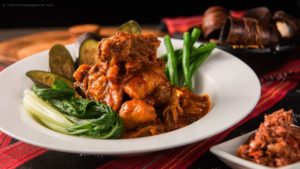
Hill Station housed in Casa Vallejo, one of the province’s most historic hotels.
Hill Station is housed in Casa Vallejo, one of the province’s most historic hotels, lending the restaurant a decidedly old-world ambiance. As a result of the restaurant’s open layout and high ceilings, it’s become one of Baguio’s most popular and romantic dining destinations.
Paella Negra and Paella Valencia are two of the best dishes to have at this restaurant if you want to experience the best Spanish cuisine. It’s possible to pair your wine with their slow-roasted American beef or their steak and prawn peri-peri, a South African dish that uses butter and chiles. It’s also a good idea to sample their take on local Filipino classics, such as their Bistek Tagalog with pickled cucumbers and garlic rice.
Festivals
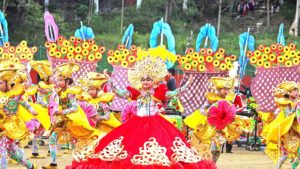
Panagbenga – annual flower festival in Baguio City.
Panagbenga is an annual flower festival in Baguio City, Philippines, that takes place every February. “anagbenga” stems from a Kankanaey word that means “looming season.”The history, customs, and ideals of Baguio and the Cordilleras are reflected in this celebration. It lasts for over a month and thrives thanks to the participation of the community.
How to Get to Baguio
By Bus
Buses are the go-to mode of transportation for people looking to experience the cool weather and pine trees on a budget, thanks to their ease, comfort, and affordability. As far as buses go, Victory Liner and Genesis Transport are the two most well-known options in Baguio.
Victory Liner is possibly the most well-known of all the city buses. The bus route has terminals at Cubao, Monumento, and Pasay, making Baguio City more accessible to commuters from the metro’s North and south ends. Victory Liner buses run 24 hours a day, with trips to Baguio departing every hour. Tickets can be booked and purchased online, making travel to the city even more convenient.
Genesis Transport has also been a popular mode of transportation to Baguio City. They have terminals in Cubao and Avenida; buses depart every hour from 3 am to 7 pm from the Cubao terminal and from 11 pm to 9 pm from the Avenida terminal.
Tourists can more easily get around the city by taking one of these bus lines, which all stop near SM City Baguio.
Buses go along the NLEX and Marcos Highway. Night trips can take up to 6 hours, while day trips can take up to 7 hours. Thanks to the renovated TPLEX (Tarlac Pangasinan La Union Expressway), tourists can drive from Manila to Baguio in roughly three hours. This is the quickest route to Baguio.
Fares can cost an average of Php 450. Purchasing tickets is easy, but booking tickets in advance while traveling to Baguio during the Panagbenga Festival and summer season is suggested.
By Private Transport
Because smaller and private cars are able to utilize the famous Kennon Road, which is the shortest route to the City of Pines, traveling by automobile is the fastest method to get there. Visitors can access Camp John Hay, the Baguio Country Club, the Mines View area, and the Philippine Military Academy through the historic Loakan Road from Kennon Road.
Visiting the famed LLion’sHead in Baguio is a must for tourists who want to get the whole Baguio experience. This enormous monument and the adjacent mountains’ copse of trees make a beautiful backdrop for photos. The LLion’sHead welcomes visitors to the Summer Capital and bids them farewell as they depart for the metropolis.